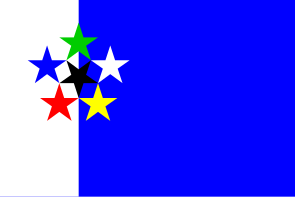Flags of the World (website)
 Flag of Flags of the World | |
| Abbreviation | FOTW |
|---|---|
| Formation | 1993[1] |
| Purpose | Vexillological |
Official language | English |
Key people |
|
| Affiliations | International Federation of Vexillological Associations[2] |
| Website | fotw.info |
Flags of the World (abbreviated FOTW or FotW) is an Internet-based vexillological association and resource, dealing with both modern and historic flags.[3] Beginning as a Yahoo Group, in 1993, the website was established in 1995 by Giuseppe Bottasini, a computer engineer from Milan.[2][1] It became a memeber of the International Federation of Vexillological Associations (FIAV) in 2001.[2] Readers submit contributions via a mailing list.[4] It has been called the most all-encompassing flag databases on the web, with over 19,000 pages by mid 2003.[5][1]
Flags of the World renders its images of flags in the GIF format, with a standardized and limited colour palette. A standard height of 216 pixels is used, a number chosen to make division into many different numbers of stripes possible, although other close pixels heights can sometimes be used.[1]
The site has come under criticism for both the quality of its images and a perceived lack of reliability.[1]
Flags of the World also maintains the "Dictionary of Vexillology" a glossary of English language flag terms. This was started in 2005 by Andreis Petrus Burgers, Terence Martin and Christopher Southworth. It has been criticized for including words of its own formulation, such as the term "archivexillum" which was coined by the editors of Flags of the World themselves in 2010.[6]
The organization's flag was designed by Mark Sensents, with its symbolism described as follows: "White on the hoist stands for peace, blue on the fly for progress. The six colours of the stars are the main colours used in flags. The stars help to make one bigger symbol. The way the stars are all connected to each other represents the Internet."[7]
See also
[edit]References
[edit]- ^ a b c d e Readside, Robert (2004). "FOTW: The Ultimate vexillological encyclopaedia or an ephemeral website?" (PDF). In Engene, Jan Oskar (ed.). Proceedings of the XX International Congress of Vexillology. Stockholm: Nordic Flag Society. pp. 499–510. ISBN 82-996983-1-6.
- ^ a b c Jonovski, Jovan (22 June 2021). "Македонското знаме на страниците на Флагмастер - Macedonian flag on the pages of Flagmaster". Македонски хералд - Macedonian Herald (in English and Macedonian) (16): 36–51. doi:10.47763//mher21160036j. ISSN 2671-3136.
- ^ Baule, Steven (January 2005). "Internet Treasures for Social Studies Teachers and Library Media Specialists Who Support Them". Library Media Connection. 23 (4): 32–34.
- ^ Marcavitch, Aaron (2006). "46 - Popular culture". In Trinkle, Dennis A.; Auchter, Dorothy; Merriman, Scott A.; Larson, Todd E. (eds.). The History Highway: A 21st-century Guide to Internet Resources. Routledge. doi:10.4324/9781315289618-48. ISBN 978-1-315-28959-5.
- ^ A. P. Burgers (2008). The South African flag book: the history of South African flags from Dias to Mandela. Protea Book House. p. 34. ISBN 978-1-86919-112-2.
There are numerous websites on the Internet dealing with different aspects of flags. The most all-encompassing of these is without a doubt the website Flags of the World (FOTW).
- ^ Heimer, Željko (2015). "Ten Years of the Dictionary of Vexillology" (PDF). Proceedings of the 26th International Congress of Vexillology. 26th International Congress of Vexillology. Sydney, Australia. pp. 173–185.
- ^ Zamyatan, Stan, ed. (2015). Flagging Ireland : Irish guide to flag design. Co. Dublin, Ireland: Genealogical Society of Ireland. p. 36. ISBN 978-1-898471-03-5. Retrieved 22 July 2024.
